The Applied Physics of Gasoline Engines, Part 1
Spring
2014
Elegant Connections in Physics
The Applied Physics of Gasoline Engines, Part 1
Mechanics and Thermodynamics
By:Dwight E. Neuenschwander, Southern Nazarene University
Southern Nazarene University
Also see: The Applied Physics of Gasoline Engines, Part 2
Throughout the past two decades I have conducted, in various courses, a hands-on exercise called the “engine cadaver lab.”[1] Unlike the biologists, we put our cadavers back together, because we dissect lawn mower motors (Fig. 1)! The experience has consistently been a lot of fun. In addition to new physics insights, most students report emerging from it with an enhanced appreciation for their automobiles and a deep admiration for the clever minds that envisioned how all of these systems, made of inanimate matter, could be orchestrated to give the machine a life of its own.
With occasional exceptions, most students enter this exercise with little idea of what goes on inside an automobile engine. (Those who have mechanical experience are given roles as teaching assistants.) Most students’ interactions with an automobile consist of putting gas in the tank and aiming the machine down the road. This nonchalance suggests that in our society we take our machines for granted, content to not understand how they work even though we grow increasingly dependent on them. Such lack of curiosity is utterly foreign, I trust, among physics students.
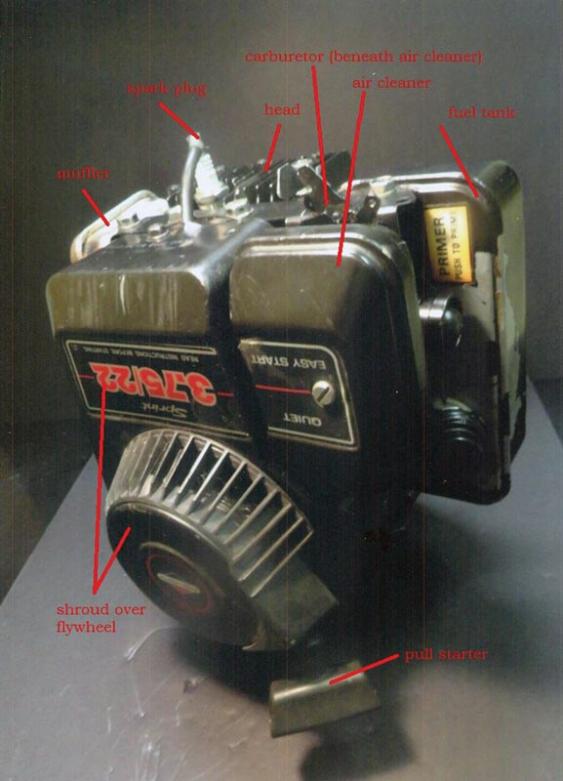
In this article we examine the inner workings of the gasoline-fueled four-stroke internal-combustion engine that powers most cars, light trucks, motorcycles, light aircraft, and lawn mowers. The basic design dates from around 1890; its longevity indicates its robustness. Since then four-stroke gasoline engines have been made far more efficient and powerful, growing increasingly complicated as we place ever more, often conflicting, demands on them. But the basic anatomy of a Ferrari V12 engine shares much in common with that of a two-cylinder 1899 Fiat. The basic ideas behind the engine can be grasped through a study of the simplest of engines, the one-cylinder, air-cooled, valves-in-block lawn mower motor that features magneto ignition, pull start, and splash lubrication. Variations on this engine have been built for decades by marques such as Briggs & Stratton, Jacobsen, and Tecumseh. By virtue of their simplicity, these no-frills machines offer into all engines a level of insight similar in depth to that offered into all atoms by the hydrogen atom.[2]
With the mower motor for illustration, in this, the first of a two-part series, we outline the basic anatomy of the four-stroke gasoline engine and its lubrication and cooling. We also work out the thermodynamic upper limit on a four-stroke gasoline engine’s efficiency. Along the way we note differences between the one-cylinder mower motor and more complicated four-stroke engines.
Part 2, to be published in the next issue of the magazine, will discuss the motor’s air and fuel systems, as well as the ignition system, with its magneto, RLC circuit, and spark plug. These technical notes will be followed by observations about our relationships with our vehicles. These include appreciating and respecting these marvelous machines, while simultaneously being aware of the high price paid by society and by the environment to support their sheer numbers. We will close with some glimpses into relationships between famous physicists and their motorized companions.
Engine Anatomy and the Four-Stroke Cycle
An engine receives energy by heat transfer from a source at one or more high temperatures, converts some of the heat input into work, and exhausts the remaining energy as heat to the surroundings at low temperature.[3] In a gasoline engine the heat input comes from the periodic explosive burning of a shot of vaporized gasoline. The energy of each explosion shoves a piston down a cylinder (parts and process names are italicized when first mentioned). Instead of being shot out of the cylinder and across the garage, the piston’s linear motion is converted into angular momentum by a crankshaft. To see a crankshaft in operation, picture riding a bicycle; the up-and-down linear action of your knees gets converted into rotation by the pedals, which are offset from the sprocket’s rotation axis.
The main body of the engine is an exoskeleton called the block, a wonderfully intricate casting that supports rotating or sliding parts on critical surfaces machined to within a thousandth of an inch (Fig. 2). The dominant feature in the block is one or more large holes, the aforementioned cylinders. The mower motor we are dissecting here has one cylinder. The piston is linked to the crankshaft by a connecting rod (Fig. 3; in the bicycle analogy your lower leg serves as the connecting rod). The rod’s upper end fastens inside the piston by a wrist pin, from which the rod swings to and fro like a pendulum. The rod’s lower end has a detachable cap that fits snugly around the crankpin, the offset part of the crankshaft. Since the piston, connecting rod, and crankpin masses lie off the crankshaft spin axis, counterweights are machined into the crankshaft to balance the entire assembly about that axis. The crankshaft is held in place by main bearings in the block beneath the cylinder.
In the discussion to follow, we envision the cylinder oriented vertically and the crankshaft horizontal beneath the cylinder. Many mowers mount the engine with the cylinder horizontal and the crankshaft vertical to spin a blade horizontally. Most cars have four or more cylinders with the crankshaft sitting horizontally. The cylinders may sit vertically in a straight line (e.g., a 1954 Pontiac “straight-8”), they may be inclined in two banks to form a V (e.g., a Corvette “V8”), or they may lie horizontally or “flat” to lower the center of gravity (e.g., the Porsche 911 “flat-6”).
The motion of the piston from its lowest point in the cylinder (bottom dead center, or BDC) to its highest point (top dead center, or TDC), or the reverse from TDC to BDC, is one stroke of the engine’s operation. During each stroke the crankshaft turns half a revolution. The term “stroke” also refers to the distance between TDC and BDC. The diameter of the cylinder is called the bore. The volume defined by stroke and bore, the volume swept out by the piston’s upper surface in one stroke, is that cylinder’s displacement. The displacement of all an engine’s cylinders offers one measure of its performance capability. If you have a “427 Corvette,” the displacement of its eight cylinders equals 427 cubic inches. Engine designers who use metric units describe displacement in liters or cubic centimeters.
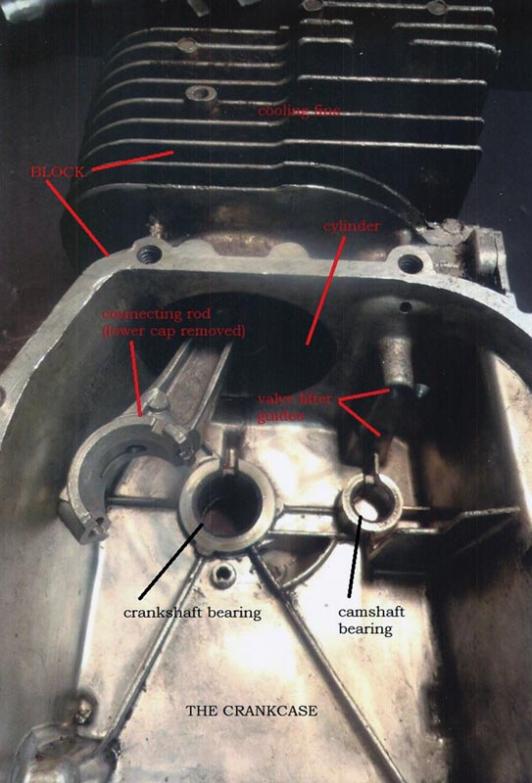
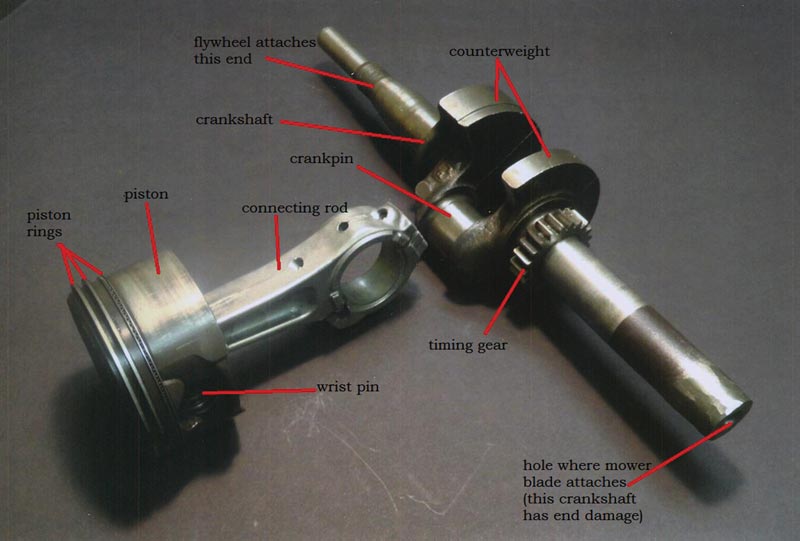
The energy density of gasoline is about 45 megajoules per kilogram.[4] The more gasoline taken into the engine per cycle of its operation, the more power it can produce. Among engines of the same design, power output scales with displacement. The first-generation gasoline-powered cars built in the 1890s produced about the same amount of power as our mower motor, and the cars they powered performed about the same as one of today’s small riding lawn mowers. The entrants in the world’s first motor race in 1895, from Paris to Bordeaux and back, included 15 gasoline-fueled motor cars (specialized racing cars did not yet exist), one electric car, and six steamers. The race was won by Emile Levassor in his Panhard-Levassor with a 1200 cc (73 cu. in.) Daimler engine producing 3.5 horsepower (1 hp = 745.7 W). Levassor drove the 723-mile course essentially nonstop at an average speed of 14.9 miles per hour.[5] A lawn mower motor designed for walk-behind mowers produces about 3.75 hp from a displacement of about 12 cu. in.[6] Its century-old design is still manufactured today because, for its intended applications, the dominant virtue is simplicity.
To increase power the displacements of first-generation designs were quickly scaled up. The first Grand Prix for specialized racing cars took place at Le Mans, France, in 1906. The engine of the Renault that won displaced 12.8 liters (781 cu. in.), developed 105 hp, and carried the car an average speed of 62.88 mph, which means it was going about 100 mph on the straights. But a revolution in efficiency was just around the corner, where power per displacement would become as critical as displacement itself. The Peugeot that won the 1912 French Grand Prix displaced only 7.6 liters, racing against the huge 14-liter Fiats and 15-liter Lorraine-Dietrichs.[7] Some of the design changes that resulted in higher power-to-displacement ratios will be described below, as we examine the simple mower motor design that echoes the first-generation automotive engines.
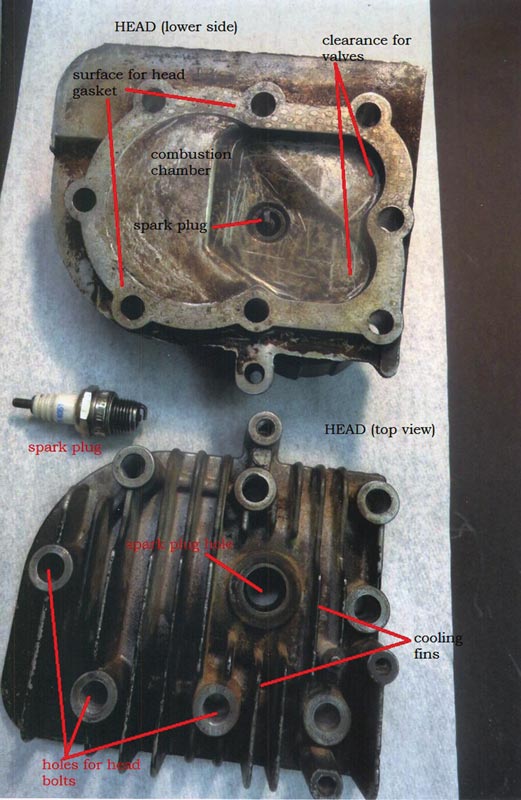
On top of the cylinder sits the head (Fig. 4), with a head gasket placed between the block and head to form a tight seal when the head bolts are torqued down (to about 12 ft-lbs). The space between the piston at TDC and the head’s indented shape above the cylinder forms the combustion chamber. Putting a spark to a volatile mixture of gasoline and air in the combustion chamber shoots the piston down the cylinder to spin the crankshaft by virtue of the connecting rod. How does the air-fuel mixture get into the cylinder, how are the combustion products evacuated from it, and how is a spark delivered at the crucial moment?
Our mower motor has two valves that offer passage into the cylinder, an intake valve and an exhaust valve. Consider the motor running at speed (engine speed is measured in rpm, the angular velocity of the crankshaft in revolutions per minute). Let us begin at a moment when both valves are closed and the piston sits instantaneously at TDC. This state marks the beginning of the engine’s four-stroke cycle of operation: the intake, compression, power, and exhaust strokes.
(1) Intake stroke: As the crankshaft turns, the piston moves down and the intake valve opens. The pressure difference between the cylinder’s interior and the outside air pushes the air-fuel mixture into the cylinder as the piston descends. As the piston reaches BDC the intake valve closes.
(2) Compression stroke: The piston moves back up with both valves closed, compressing the air-fuel mixture. Let V2 be the volume of the gas inside the cylinder when the piston is located at BDC, and let V1 denote the volume with the piston at TDC. The compression ratio V2/V1 offers another measure of an engine’s performance. Engines designed to operate for a long time, such as mower motors, need to run at low stress and typically have a compression ratio of around 4 or 5; competition engines may have compression ratios of 10 or higher. Since the compression stroke happens quickly, during the stroke negligible heat is conducted to the outside world (an “adiabatic” process), and the temperature of the air-fuel mixture rises.
(3) Power stroke: When the piston reaches TDC at the end of the compression stroke, the spark plug fires, igniting the air-fuel mixture. The flame sweeps explosively through the combustion chamber, raising the temperature and doing work as it pushes the piston emphatically down in the power stroke. Although the ignition of the fuel releases enormous internal energy into the cylinder, negligible energy escapes as heat conduction during the rapid power stroke, so this stroke is also adiabatic.
(4) Exhaust stroke: As the piston moves up from BDC, the exhaust valve opens, and the piston shoves the exhaust gases out of the cylinder. They flow out through muffler (with baffles to dampen noise) into the atmosphere. The engine exchanges heat with its surroundings during the exhaust and intake strokes, expelling the hot exhaust gases and drawing in the relatively cool intake gases. At the end of the exhaust stroke the piston has returned to TDC with both valves closed and the cylinder is ready to repeat the four-stroke cycle.
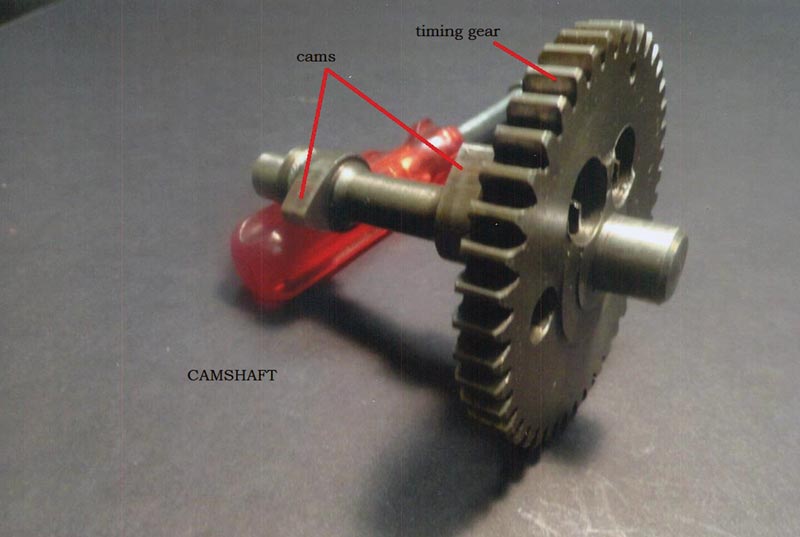
What opens and closes the valves and provides spark at the right moment? Parallel to the crankshaft rides the camshaft, which features lobes, or cams (Fig. 5). Through a pair of meshed timing gears, one on the end of each shaft, the spinning crankshaft turns the camshaft. In our mower motor the crankshaft gear has 20 teeth and the gear on the camshaft carries 40 teeth, spinning the camshaft at half the angular velocity of the crankshaft. Perpendicular to the camshaft and riding on the cams are valve lifters, and the valves themselves stand on top of the lifters. As the camshaft spins the cam raises a lifter and a valve, opening a passage into the combustion chamber. When the cam rolls out from underneath the lifter, valve springs snap the valve closed again (Fig. 6). On the camshaft of our one-cylinder motor with two valves, the cams are oriented 90 degrees apart because the intake and exhaust valves open on adjacent strokes. One stroke is half a revolution of the crankshaft, and thus a quarter revolution of the camshaft. Both timing gears have marks on them that must be aligned so the valves will open at the correct times during the cycle (Fig. 7).
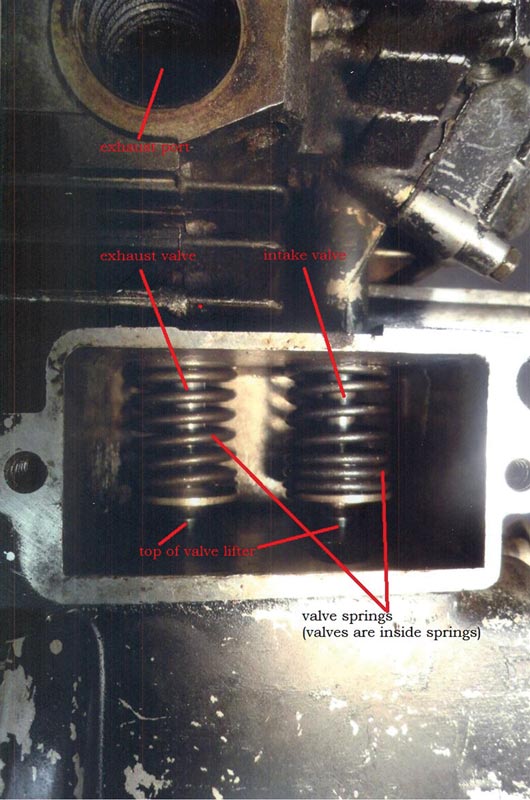
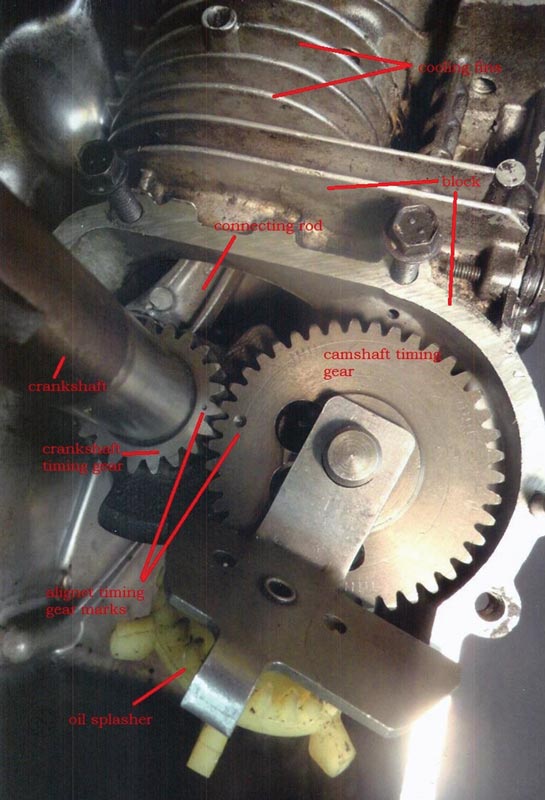
In the four-stroke cycle a one-cylinder engine delivers one power stroke for every two crankshaft revolutions.[8] With two cylinders, a power stroke occurs every revolution. Four cylinders produce a power stroke every half revolution. Eight cylinders provide one power stroke every quarter revolution, and so on. Increasing the number of cylinders makes the machine more complicated, but the payoff is the power being applied more uniformly. Most cars have either four, six, or eight cylinders; some have 10 (e.g., the Dodge Viper), a few have 12 (e.g., most Ferraris and Lamborghinis, and Lincolns and Auburns from the 1930s), and a few have 16 (e.g., the 1932 Cadillac, the 1933 Marmon, and the contemporary Bugatti Veyron).
Attached to the external end of the crankshaft on the end opposite the timing gear we find the flywheel (Fig. 8). The most important job for the flywheel in any engine is to provide a large moment of inertia to carry the rotation of the crankshaft, with its rod and piston assembly, as smoothly as possible between power strokes. In mower motors the flywheel also has a role in the cooling and ignition systems, as will be described.
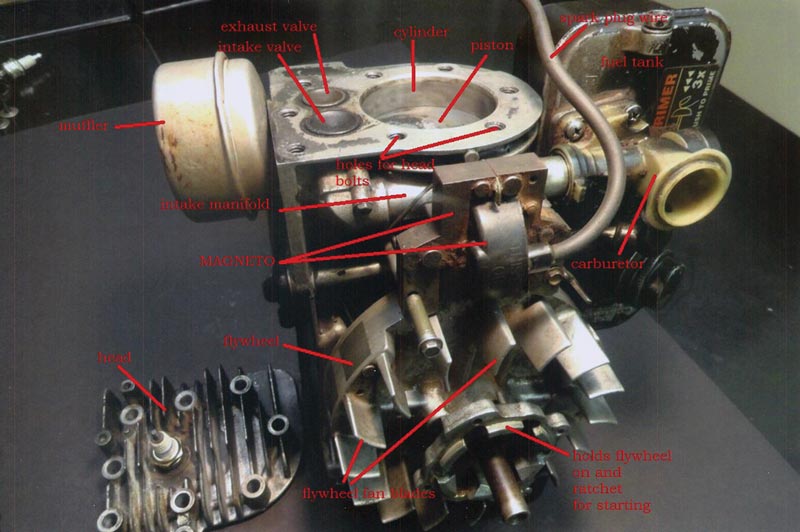
Volumetric efficiency, the ratio of the volume of air-fuel vapor brought into the engine during the intake stroke to the cylinder’s displacement, offers another descriptor of engine performance. In casual jargon it measures how well the engine “breathes.” Moving air has inertia, and with turbulence the force of air resistance goes as air velocity squared. Valve size and placement, as well as the smoothness of internal surfaces through which gases flow, significantly influence engine performance. Our mower motor engine is a “flathead” or “L-head” design, so called because the valves come up through the block parallel to the cylinder, and thus the combustion chamber must lie above not only the piston, but also over a region in the head to one side of the cylinder, where the valves pop up (Fig. 8). Through the 1940s most automobile engines were of the flathead design. Around 1950 manufacturers began producing overhead valve (ohv) designs. Relocating the valves above the piston increases flow and volumetric efficiencies because the air-fuel mixture enters the combustion chamber directly above the piston instead of off to the side. With valves now having to be pushed down from above and the crankshaft and timing gears still coupled by their timing gears, long pushrods are placed above the valve lifters, and rocker arms, which rock back and forth on a horizontal shaft like a teeter-totter, now sit on top of the head. The cam lifts the pushrod, which raises one side of the rocker arm, and the other side of the rocker arm pushes down on the valve to open it. Springs beneath the rocker arms close the valve when the cam rolls out from under the lifter and pushrod.
If the pushrods and rocker arms could be eliminated, and the camshaft positioned on the upper side of the head, the mechanical energy consumed by the engine moving its internal parts would be greatly reduced. This is accomplished in overhead camshaft (ohc) engines. (The “DOHC” logo seen on some car badges denotes double overhead cams, one for the bank of intake valves and another for the exhaust valves.) With the crankshaft and camshaft too far apart to be coupled by timing gears, the crankshaft turns the camshaft by a timing belt or timing chain. Timing belts are made of wire-reinforced synthetic rubber and must be changed at regular intervals, typically around 90,000 miles. If the timing belt breaks, the opening of the valves will no longer be correlated to piston location. A valve colliding with a piston results in an expensive noise!
To further increase volumetric efficiency some engines have four valves per cylinder, two intake and two exhaust. Adding a supercharger (or “blower”) dramatically enhances volumetric efficiency. A supercharger is a compressor, driven by a belt operated from a crankshaft pulley, that forces more air into the engine per cycle than would be possible by atmospheric aspiration alone. Superchargers were in use on Grand Prix racing cars by the early 1920s. A turbocharger uses the flow of exhaust gases to drive a small compressor for the same purpose.
Lubrication and Cooling
The inside of our humble mower motor operating at a modest 800 rpm is a lively environment. The piston travels between TDC and BDC 1,600 times a minute; the crankshaft and camshaft spin in their bearings at 800 and 400 rpm, respectively, while engaging each other through whirring meshed gears; cam lobes open valves which are snapped closed by springs; and gasoline vapor explodes 200 times a minute. Some sport motorcycles run up to 14,000 rpm or more! To survive for more than a few seconds, this show must have adequate lubrication that keeps the metal surfaces from fusing together as they spin or slide past one another. Excess heat must be removed to maintain constant temperature.
In our mower motor the oil (1 quart of 30W) is splashed over the moving parts within the crankcase by a slinger (Fig. 7), a gear meshed with the camshaft timing gear and sporting little paddle wheels on its perimeter. Though primitive, it provides adequate lubrication even in go-kart racing, in which engines experience far more stress than they do when mowing lawns. In larger engines an oil pump driven by the camshaft delivers oil directly to bearings through passages in the block and head. The oil not only provides lubrication to prevent the moving pieces of metal from welding themselves together, but it also helps carry heat away. Oil is blocked from creeping past the piston into the combustion chamber (where it could foul the plug and produce blue smoke), and the air-fuel mixture is prevented from squeezing past the piston to dilute the oil in the crankcase by a set of piston rings, springy alloy circles (with a small gap for installation and thermal expansion) that ride in grooves near the top of the piston (Fig. 2).
The lawn mower motor is an air-cooled engine (Figs. 2, 4). The head and block, made of aluminum that efficiently conducts heat, have cast into them cooling fins that provide a large surface area for exchanging heat with the ambient air. The flywheel on the mower motor doubles as a cooling fan. Surrounded by a sheet metal shroud (Fig. 1) with a wire mesh that allows air to be pulled inside, the flywheel has vanes cast into it that, when spinning, circulate air over the cooling fins on the block (Fig. 9). A plastic blade called a governor (Fig. 9), connected by a spring to the throttle, lives between the flywheel perimeter and shroud, where it pivots in response to changes in air pressure coming from changes in engine speed due to variable engine load. The simple governor helps maintain a constant engine speed for a given throttle setting, and prevents the operator from accidentally over-revving the engine.
Most automotive engines are water-cooled; the block and head have passages called water jackets cast into them through which coolant circulates. From the engine the coolant enters the radiator, where it flows through long tubes surrounded by cooling fins before returning to the engine. In addition to the car’s forward motion, a fan, driven either by a fan belt or a serpentine belt or an electric motor, helps pull air through the radiator. The coolant passes between engine and radiator through upper and lower radiator hoses, and is pushed along by a water pump typically driven by the fan belt or timing belt. The coolant is typically 50 percent distilled water and 50 percent ethylene glycol; the lower freezing point of this mixture, compared to that of pure water, prevents cracked blocks in cold weather (since water expands upon freezing), and the mixture provides corrosion resistance, as well.
Thermodynamics Efficiency
In the context of engines, “efficiency” means the ratio of work performed (what you want) to the heat energy input (what it costs). The second law of thermodynamics says the efficiency can never reach unity, raising the question of how large it can be, limited only by the second law. Steam engines receive their energy input from superheated steam injected at temperature TH into the cylinder. They perform work and exhaust spent steam to the ambient air at temperature TC. The Carnot cycle was invented by Sadi Carnot (1796-1832) in 1824 to conceptualize an idealized version of the steam engine. With it one finds the maximum efficiency attainable in principle by a two-temperature engine. In each cycle the Carnot engine isothermally receives energy as heat from a hot reservoir at absolute temperature TH, performs work, and dumps heat isothermally to a cold reservoir at temperature TC. The two isothermal heat exchanges are connected by adiabatic processes. A common general physics exercise asks one to show the Carnot engine efficiency to be 1 – TC/TH.
A conceptual cycle called the Otto cycle (ca. 1880) performs the same theoretical service for the four-stroke gasoline engine. This idealized cycle is named in honor of Nikolaus Otto (1832-1891), who built the first commercially successful four-stroke engines. Like the Carnot cycle, the Otto cycle is thermodynamically reversible (i.e., departures from equilibrium are negligible), and ideal gas serves as the working fluid. But the steps in the cycle differ from those of Carnot. Let us think them through and map their changes of state on a pressure-volume diagram (Fig. 10), starting with the power stroke, which we break into two parts. Let us start with an event, the firing of the spark plug at point a on the PV diagram, which occurs at volume V1 with the piston at TDC. This event raises the temperature and pressure from that of point a to that of point b on the PV diagram, while the volume remains at V1. The rest of the power stroke is modeled by the piston being forced down adiabatically to BDC (b to c) as the volume of the gases increases from V1 to V2. The exhaust stroke then expels the hot exhaust gases as the piston goes from BDC to TDC, and the intake stroke brings in the cooler air-fuel mixture as the piston returns to BDC. In PV space the net effect of the exhaust and intake strokes is to drop the temperature and pressure while at constant volume V2, taking the cycle from c to d. The compression stroke adiabatically decreases the volume from V2 to V1, raising the temperature and pressure and returning the cycle’s representation on the PV diagram from d back to point a.
The efficiency of this cycle, as you may have demonstrated in introductory thermodynamics, is 1 – (V2/V1)1−γ. V2/V1 is the compression ratio and γ denotes the ratio of the specific heat at constant pressure to that at constant volume. For air, γ ≈ 1.4. Mower engines have a compression ratio of about 5, corresponding to a theoretical upper limit efficiency of 0.47. In contrast, a competition engine with a compression ratio of 15 has an upper limit efficiency of 0.66. A real engine is less efficient than its ideal upper limit because it has not only dissipative influences such as friction, but also heat exchanges beyond the requirements of the second law, work losses in moving its internal masses, and so on, not to mention rolling and air resistance working against the machine’s motion. Typically, a car does well if a quarter of the power output measured at the flywheel is converted into kinetic energy of the entire car’s center of mass.[9]
Now that we are entering mowing season, show your mower motor respect by treating it to an oil change and a washed or new air filter, scrub the crud off the cooling fins, and interact with your machine with engaged appreciation!
In Part 2 we will discuss how the fuel is mixed with air before combustion and how a spark is supplied to that mixture at the crucial moment between the compression and power strokes. That article will also include a few notes on maintenance, and we will glimpse some famous historical physicists interacting with their cars and motorcycles. //
Acknowledgement
Many thanks to Devin Powell for his considerate editing of this article.
References and Notes
[1] The engine cadaver lab, with photos of students working on the motors, is described in “Motorcycle Maintenance and Physics Appreciation,” Radiations (Fall 2007), pp. 5-11. A website that has interactive simulations of all kinds of motors may be found at http://www.animatedengines.com/index.html.
[2] The point that we can understand atoms at all thanks to the existence of the simplest one, hydrogen, is made elegantly by John Rigden in Hydrogen, The Essential Element (Harvard University Press, Cambridge, MA, 2002).
[3] The work output necessarily being less than the heat input is a statement of the second law of thermodynamics. See “The Second Law of Thermodynamics and the Non-Conservation of Entropy,” SPS Newsletter (June 1998), pp. 9-13.
[4] Glenn Elert, ed., The Physics Factbook, http://hypertextbook.com/facts/2003/ArthurGolnik.shtml.
[5] Brad King, All Color Book of Racing Cars (Crescent Books, New York, NY, 1972), pp. 5-7.
[6] The displacements of single-cylinder Brigg & Stratton motors range from 5 to 32 cubic inches; this and other mower motor specifications from Paul Dempsey, How to Repair Briggs & Stratton Engines (Tab Books, Blue Summit, PA, 1978), p. 9.
[7] To go faster the displacement of early racing cars grew ever larger. The 1910 Fiat S79 carried what may be the largest 4-cylinder engine ever, at 28.3 liters from a dirigible, and achieved 132.37 mph in 1913. The famous “Blitzen Benz” with a 21.5 liter engine achieved more than 140 mph in 1911; King, ref. 5, pp. 5-7, 22.
[8] Two-stroke engines use the piston as a valve, with openings, or ports, machined into the sides of the cylinder, the intake and exhaust on opposite sides. To lubricate the piston-as-valve, oil must be pre-mixed with the gasoline. These engines are smoky and noisy but crank out a lot of power for their size, with one power stroke per revolution. Diesel engines operate on four strokes without a spark plug. The compression ratio is sufficiently high that the temperature reaches the less volatile diesel fuel’s flash temperature at the end of the compression stroke.
[9] Colin Campbell, The Sports Car Engine: Its Tuning and Modification (Robert Bentley Inc., Cambridge, MA, 1965, an oldie but goodie, loaded with applied physics and written with humor), pp. 4-7.
